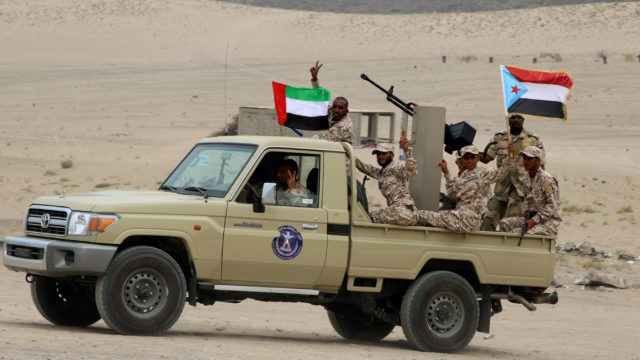
The STC’s Carrot and Stick and its Rivalry with Islah
Publication: Terrorism Monitor Volume: 18 Issue: 11
By:

Saudi Arabia’s military adventurism in Yemen has been nothing short of disastrous. As political and economic woes are beginning to hit home, the kingdom is struggling to maintain its resolve and cajole warring parties in southern Yemen toward some kind of peace deal. Conflict between the internationally recognized Yemeni government under Abd Rabu Mansour Hadi and the rival Southern Transitional Council (STC) escalated once again on April 26, when the STC declared self-rule over southern Yemen. While the focus of the matter has been on the STC and the Hadi government itself, it obscures the importance of the Islah-STC rivalry and the implications these developments have on the current and future role of Islah within the government more broadly.
The April 26 declaration was not the first—and is unlikely to be the last—declaration of self-rule by the STC, which uses the tactic as a means of leverage. The political-military field in Yemen is exceptionally convoluted, but what has grown increasingly clear is that the STC has become a key stakeholder capable of influencing, to a degree, the direction of the conflict and the future of southern Yemen. The STC’s claims to be the authority on matters across southern Yemen do not entirely reflect the reality on the ground, as evidenced by residents and officials in Abyan, al-Mahra, Hadramawt, Shabwa, and Socotra rejecting the STC declaration (Al Jazeera, April 26). The STC, however, has still proven that it does have some leverage over Saudi Arabia, particularly due to its ability to impose its will on the critical port city of Aden, Yemen’s temporary—if only symbolic—capital.
Much more is at stake than the give and take of political and war-time military concessions between President Hadi and the STC. Islah and, inherently, the mercurial Vice President, General Ali Mohsen, stand to gain or lose significant influence based on both the short- and longer-term success or failure of the STC. Islah has long been an influential party within the Yemeni government and the emergence of other powerful players capable of influencing the future direction of the country inherently takes a piece of the pie away, and further, those pieces will be given to Islah’s two biggest enemies—the Houthis and the STC.
The Houthis and Islah are longtime adversaries and the former holds Ali Mohsen accountable as the man who led the Yemeni military against them during the Saada wars between 2004 and 2010 as commander of the northwest military district and 1st Armored Division. Always the opportunist, Ali Mohsen managed to leverage his military clout into the vice presidency, a heartbeat away from being, at the least, the interim president. The ongoing war has only deepened that animosity as it has pitted Islah and the Houthis against one another in some of the war’s fiercest battles. It is clear that there will be no solution in Yemen that does not see the Houthis with a seat at the table.
Likewise, both Islah and Ali Mohsen have been vilified by pro-secessionist groups in southern Yemen. This disparity has fallen along the battle lines of the historic rivalry that saw the Zumra faction defeat the Tughma during the southern civil war that took place in 1986. The Zumra faction represented the southern followers of Ali Nasser Mohammed, the president of South Yemen during the 1986 conflict, primarily in Abyan and Shabwa. The Zumra came to include the likes of former president Ali Abdullah Saleh, President Hadi, and allies within Islah, notably Ali Mohsen. The Tughma, primarily from al-Dhale and Lahij, were comprised of separatists led by Ali Salim al-Beidh and have come to represent the STC and its followers in Aden, al-Dhale, and Lahij.
The STC’s latest declaration of self-rule has seen a return of clashes with pro-Hadi forces, particularly those affiliated with Islah. Alongside these clashes, Islah and the STC have been waging propaganda campaigns against one another, with the STC previously being accused of coordinating with both the Houthis and al-Qaeda (Al Jazeera, August 29, 2019). Like previous outbreaks of violence between the warring parties, the focus has been on securing strategic locations in Shabwa and Abyan, most notably Shoqra and Zinjibar, Abyan, which would serve as the Yemeni military’s potential gateway to Aden (Al-Monitor, May 19). The STC views gaining the upper hand in these areas, where it exercises less influence than its primary powerbase, as essential to maximizing its political concessions and Islah views marching on Aden as key to ensuring its long-term primacy. Islah has so far managed to monopolize power within the government and military, but concessions given to the STC through the Riyadh Agreement would necessitate ceding influence to its mortal enemies.
At present, the STC lacks the widespread local and international support to achieve its goal of controlling an independent southern Yemen but will continue to press for maximum concessions from the Hadi government and the Saudi coalition to revisit its demands down the road. The STC and Islah’s actions will continue to be motivated by their mutual disdain for one another and the goal of securing influence. The Riyadh Agreement is not entirely dead just yet as STC delegates have held meetings in Riyadh to iron out revisions (Middle East Monitor, May 21). Saudi Arabia cannot afford for the agreement not to be implemented in some form. Its implementation, however, will only be a short-term solution that highlights fundamental fissures within southern Yemen, and the country as a whole, and exposes the importance of beginning to consider a successor to Hadi other than Ali Mohsen.




